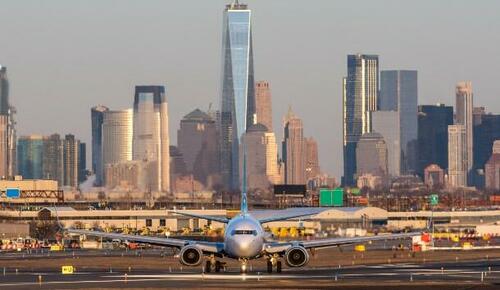
As air traffic is on the verge of breaking records heading into the summer, Newark, New Jersey's airspace is being turned over to Philadelphia.
The move, prompted by the U.S. Federal Aviation Administration, seeks to "address staffing issues and congested traffic in the New York City area", according to a new Reuters report.
We hope it's more of the latter than the former - because with all these Boeings in the air every day, it isn't necessarily a great time to be understaffed. And we're only half joking.
The FAA is predicted a record summer travel season, the report says, and airlines are also predicting record travel for the spring. The FAA says the change will "meet continued traffic demand in the busy Northeast Corridor."
The FAA, grappling with air traffic control staffing shortages, announced its collaboration with the National Air Traffic Controllers Association through a memorandum out last week. Air traffic control responsibilities for Newark will be transferred from the New York Terminal Radar Approach Control to the Philadelphia Tower/TRACON by the end of June.
Reuters notes that New York TRACON is recognized as one of the busiest control facilities in the United States, managing some of the country's most complex airspace. The FAA had previously disclosed plans in 2023 to reassign about 100 square miles of airspace from Newark's N90 to Philadelphia to alleviate staffing constraints.
United Airlines, which operates a major hub at Newark, frequently encounters delays due to air traffic congestion and personnel shortages. The airline scaled back its flight operations last summer in response to operational disruptions, with CEO Scott Kirby publicly criticizing the FAA's performance.
He highlighted that the number of flights scheduled at Newark exceeded the airport's physical capacity to manage them. Consequently, the FAA prolonged the reduction of minimum flight requirements at airports around New York City through October, addressing these staffing shortfalls.
Airlines are typically required to utilize their allocated takeoff and landing slots at busy airports for a minimum of 80% of the time, under risk of losing them. The FAA's waiver permits airlines to maintain their slots despite not operating some flights.
A report from a government watchdog in June highlighted severe staffing challenges at crucial air traffic control facilities, which pose risks to aviation operations. It noted that staffing at N90 was only at 54%. With controllers at various locations working mandatory overtime and six-day weeks to mitigate shortages, the agency falls approximately 3,000 controllers short of its staffing objectives.
In response, President Joe Biden has proposed funding this month to recruit an additional 2,000 controllers over the next year.
As air traffic is on the verge of breaking records heading into the summer, Newark, New Jersey’s airspace is being turned over to Philadelphia.
The move, prompted by the U.S. Federal Aviation Administration, seeks to “address staffing issues and congested traffic in the New York City area”, according to a new Reuters report.
We hope it’s more of the latter than the former – because with all these Boeings in the air every day, it isn’t necessarily a great time to be understaffed. And we’re only half joking.
The FAA is predicted a record summer travel season, the report says, and airlines are also predicting record travel for the spring. The FAA says the change will “meet continued traffic demand in the busy Northeast Corridor.”
The FAA, grappling with air traffic control staffing shortages, announced its collaboration with the National Air Traffic Controllers Association through a memorandum out last week. Air traffic control responsibilities for Newark will be transferred from the New York Terminal Radar Approach Control to the Philadelphia Tower/TRACON by the end of June.
Reuters notes that New York TRACON is recognized as one of the busiest control facilities in the United States, managing some of the country’s most complex airspace. The FAA had previously disclosed plans in 2023 to reassign about 100 square miles of airspace from Newark’s N90 to Philadelphia to alleviate staffing constraints.
United Airlines, which operates a major hub at Newark, frequently encounters delays due to air traffic congestion and personnel shortages. The airline scaled back its flight operations last summer in response to operational disruptions, with CEO Scott Kirby publicly criticizing the FAA’s performance.
He highlighted that the number of flights scheduled at Newark exceeded the airport’s physical capacity to manage them. Consequently, the FAA prolonged the reduction of minimum flight requirements at airports around New York City through October, addressing these staffing shortfalls.
Airlines are typically required to utilize their allocated takeoff and landing slots at busy airports for a minimum of 80% of the time, under risk of losing them. The FAA’s waiver permits airlines to maintain their slots despite not operating some flights.
A report from a government watchdog in June highlighted severe staffing challenges at crucial air traffic control facilities, which pose risks to aviation operations. It noted that staffing at N90 was only at 54%. With controllers at various locations working mandatory overtime and six-day weeks to mitigate shortages, the agency falls approximately 3,000 controllers short of its staffing objectives.
In response, President Joe Biden has proposed funding this month to recruit an additional 2,000 controllers over the next year.
Loading…





